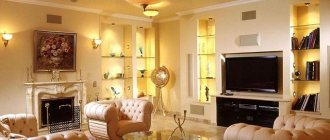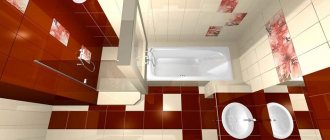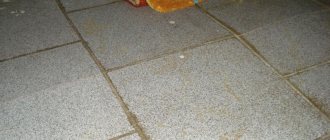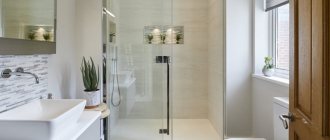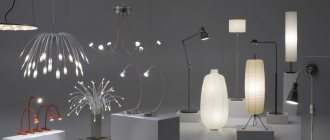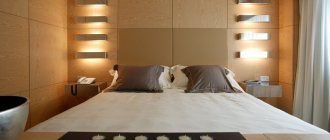In all our apartments and houses there are rooms in which the atmosphere in terms of air humidity almost always exceeds the norm. Therefore, when equipping lighting for such premises, the main task is to ensure the safe operation of lighting devices in conditions of high air humidity.
Electricity strikes instantly, so it is necessary to eliminate the risk of such damage as much as possible. This can only be done by proper installation of lighting for such rooms and the correct choice of lamps, which must be resistant to moisture and sealed. Today we will talk about such lamps, their protection classes, application options and selection rules.
But first, let's decide which rooms are considered wet. Dry rooms include all rooms in which the air humidity level does not exceed 60%. If the air humidity in the room even slightly exceeds the boundaries of this value, it is already classified as an object of high humidity. All premises in this category are divided into three types:
- wet;
- raw;
- especially raw.
Simply wet include kitchens, production workshops, heated basements, pumping stations, etc. Their humidity level can range from 60 to 70.5%. In such rooms, condensation on the walls or steam does not appear constantly, in a small volume.
The damp category also includes unheated basements and cellars, as well as a number of production workshops, the air humidity in them exceeds 75%, and this level remains for a long time.
The last type of wet rooms is especially damp. These include greenhouses and greenhouses, since the air humidity level in them is close to 100%. The main sign of particularly damp rooms is the presence of constant moisture condensation on the walls, as well as on the surface of the floor and ceiling.
Of course, it is impossible to install simple lamps in rooms with high humidity. Waterproof models are needed here. The main feature of any lamps that are intended for installation in rooms where the humidity level exceeds the norm is the presence of special internal structural components. Depending on which protection class they belong to, such components prevent water from entering the lamp and direct contact of moisture with the lamp and with electronic contents and conductors. Such design features contribute to a significant increase in the duration of the operational life and prevent the occurrence of dangerous moments, including short circuits, breakdown only to ground, and various fires.
Lighting devices for wet rooms have a number of important features, namely:
- their design uses rubberized parts;
- Conductors are effectively insulated;
- complete tightness is ensured;
- The design provides for an extremely tight fit of all components.
Remember that just because a light fixture has a sealed bulb is not a sign that it is suitable for installation in a room with high humidity. At the junction of the lampshade with the body of a device designed for use in wet areas, a sealing gasket made of elastic rubber is required. And the product passport or label placed on the packaging must contain information about the IP index value.
Ceiling lights for bathroom
The most popular and easiest way to illuminate a bathroom is to use bath ceiling lights. With them you can create basic bathroom lighting, without using accents.
- Ceiling lamps usually include: chandeliers and spotlights.
- If huge chandeliers are suitable for spacious rooms with high ceilings, then spotlights are universal.
- This means you don't have to choose a variety of shapes.
- The only thing you have to choose is the color of the spotlight.
However, the advantage of using chandeliers in bathrooms is that you have a variety of options to choose from. This option is suitable for you if you have any sophisticated interior design.
Such a light source can not only serve you as a light source, but also as the main piece of furniture, since the chandelier will be the first to catch your eye.
Which suspended ceiling to choose for the bathroom
Not all finishing materials feel equally “good” in the specific microclimate of bathrooms. This statement is also true for stretch fabrics. They come in two types:
- from PVC film
- on a fabric basis (polyester with polyurethane impregnation)
The first option is optimal for rooms with high humidity, the second can be used with great restrictions: only in spacious rooms where good natural ventilation is provided.
Fabric stretch ceiling
This variety is usually used for interiors in a classic style. Absolutely devoid of shine, the canvases with a pleasant texture do not differ in appearance from traditional plaster. They can be painted many times, decorated with photo printing or painted by hand. Stretch ceilings with patterns look no worse than real frescoes.
Advantages of fabric sheets:
- large width (up to 5 m), allowing you to cover rooms with one sheet, without additional connections;
- ease of installation - unlike PVC analogues, it does not require the help of professionals or special equipment;
- strength, resistance to mechanical stress;
- immunity to low or high temperatures;
- air and vapor permeability, due to which fungus and mold do not develop on the ceiling;
- environmental friendliness;
Cons when it comes to the bathroom:
- fabric sheets will not protect in case of flooding: with a large amount of water, they will not only begin to let it through, but will also become deformed, beyond the possibility of recovery;
- such a ceiling is very difficult to clean from limescale and traces of splashes;
- high price, which in this case is unjustified, since fabric will last less than vinyl.
Fabric stretch ceiling in the bathroom, photo:
PVC sheets
If fabric ceilings are more suitable for the living room or bedroom, then unpretentious and waterproof vinyl sheets are recommended for the bathroom.
There are three types of PVC film:
- glossy
- matte
- satin
The first variety has good reflectivity. There is even a mirrored stretch ceiling that conveys reality almost without distortion. It is not only creative, but also visually “doubles” the room, creating the impression that it is more spacious and brighter than it actually is.
hvOrdinary glossy stretch ceiling in the following selection of photos :
Matte film looks elegant. Its texture resembles that of fabric. The material does not reflect light at all, so it is well suited for interiors where there are already shiny surfaces, for example, glossy furniture facades or tiles.
In the photo there is a matte stretch ceiling:
Advice : if it is not clear which one - matte or glossy stretch ceiling to choose for the bathroom, you need to weigh the pros and cons of each coating. First of all, the design of the bathroom is taken into account. Glossy PVC film will perfectly complement interiors in high-tech and modern styles, while matte is intended for minimalism, classics, Provence, country and loft.
Satin fabric has a soft, diffused sheen. This is a universal choice for bathrooms of any style and size.
Vinyl stretch ceiling in the bathroom. Advantages and disadvantages
Among the advantages of PVC sheets it should be noted:
- Ability to retain water, elasticity. When flooded, high-quality vinyl can withstand up to 100 liters of water per 1 m². After removing the liquid, the ceiling is stretched again and is suitable for further use.
- Resistant to stains. To clean a PVC ceiling, you only need a sponge and plain water. More difficult stains can be removed with liquid detergent. Then the surface is wiped with a microfiber cloth to avoid streaks or white deposits.
Attention: it is easiest to care for a glossy ceiling, but a matte one will require more effort. However, shiny surfaces become dull when washed frequently and reflect light less well. In addition, stains and water droplets are more visible on them.
- Varied design. In addition to three types of texture, PVC film pleases with a wide selection of colors and shades. It can be decorated with photo printing , including with a 3D effect.
- Health safety. Contrary to existing opinion, high-quality polyvinyl chloride ceilings are non-toxic, and the characteristic smell of the new canvas quickly disappears.
Flaws:
- PVC film can be easily damaged by a sharp object.
- Installation of the canvas is carried out only by specialists, using a heat gun, which heats the material, making it plastic.
- The insufficient width of the film (no more than 3 m) forces several elements to be connected in large areas. The seam between them, even with very careful soldering, can be noticeable.
- Cracking at low temperatures. In country houses where the heating is not turned on in winter, it is better to avoid PVC film.
- Vinyl does not allow the ceiling underneath to “breathe”, which leads to the appearance of mold.
Bathroom wall lights
Wall lights in the bathroom are suitable for the lucky owners of spacious bathrooms. Typically, such lighting items are used to set accents on something, most often hung near mirrors.
Let's look at the main types of wall lamps:
- Sconce - such a lighting device looks like one lamp mounted into the wall. They are usually arranged in pairs. There is a wide range of sconces to choose from for a variety of interior design options.
- A surface-mounted lamp is suitable for you if you need a lamp that will not take up much space and will be compact. In addition, a significant advantage is that they are waterproof lamps and are most often used specifically for bathrooms. They are usually made from stainless steel or transparent plastic. Most often they are used in modern interiors.
- Spots - such lighting items are used mainly in modern designs, since spots have a peculiar, discreet shape. The function of such a lamp is to illuminate only one area.
Types of moisture-resistant lamps
All lighting devices intended for use in wet areas are qualified according to three key criteria:
- installation method;
- object of application;
- type of light source.
Bathroom wall-ceiling lamp Aqua 1x60W E27 230V metal painted silver
Depending on the installation method, lighting fixtures come in three design types - built-in, surface-mounted or suspended. Design features largely determine the object of application. Based on this criterion, moisture-resistant lamps are divided into:
- ceiling lamps, which can be used under the ceiling and made as standard pendant chandeliers or spotlights mounted on brackets;
- floor-mounted - they are produced in the form of floor lamps and stand-alone lampshades and mounted on the floor;
- tabletop - they are produced as free-standing lamps; such lamps are mounted on toilet-type tables, stands for installing sinks, etc.;
- wall-mounted - this type of lighting fixtures is universal in use and is most widespread. Moisture-resistant wall lamps are usually produced in the form of lampshades or lanterns;
- furniture - used in equipment for lighting cabinets, wardrobes and other interior items installed in wet areas.
Based on the type of light source, moisture-resistant lamps are divided into:
- incandescent lamps - for rooms with high humidity, only light bulbs are used whose power does not exceed 40 W; they can easily withstand current changes in the network, as well as elevated air temperatures. At the same time, such lamps generate a lot of thermal energy, this can cause the plastic housing of the lamp to melt, so incandescent lamps are not recommended for use directly in saunas or baths;
- fluorescent lamps - they are characterized by economical energy consumption, long service life, fairly high light output and comfortable color temperature. The disadvantages of such lamps include rapid failure due to frequent network overvoltages, high price, delayed ignition;
- LED lamps - this type of light source is the most economical of all existing today. LEDs are compact and fireproof, they are powered by a low-voltage DC network, making them completely safe when used in conditions of high humidity. Important advantages of LEDs are their brightness, long service life, and long service life. The fly in the ointment in the characteristics and qualities of these lamps is still the high price;
- halogen lamps are fairly bright light sources with a long service life, but they are characterized by high sensitivity to grease stains that may appear on the bulb during the intended use of the device, and to their overheating in case of improper installation and inappropriate operating conditions.
The quality of lighting for objects with high humidity depends both on the number of lamps used and on the location of their installation. Therefore, when arranging lighting for such premises, such important factors as the illuminated area, ceiling height, the need for zoning, and the presence of partitions at the facility are taken into account. In addition, lighting fixtures must correspond to the style concept of the interior of the room.
LED bathroom lights
There are many ideas for installing LED bathroom lighting. Such lamps serve more of a decorative function. The lighting stops at the seam between the tiles.
Such lighting will not serve as a full-fledged light source, but it will look very impressive. The lighting can be installed along the edges of the baseboards, or it can be spot-on. Let's look at an example as in the photo.
The photo shows a bathroom with a black floor on which LED bathroom lighting is installed. An LED strip was inserted between the joints of the tiles and filled with silicone mixture on top.
When the main light is turned off, it seems as if you are walking through a starry sky. At the same time, you can clearly see the objects around you and are unlikely to crash into something.
Stretch ceiling design in the bathroom
Let’s immediately agree that since PVC film better suits the specifics of bathrooms, further discussion will only be about it.
Having decided for ourselves whether it is worth making a suspended ceiling in the bathroom , the next step is to decide on its design.
Matte or satin white canvases are suitable for rooms of classical and Scandinavian style, as well as shabby chic, retro and Provence. The main decorative role here is assigned to furnishings, so the decoration of the walls and ceiling should be done in light, neutral colors.
But modernism, with its laconic forms and a minimum of accessories, often requires additional bright accents. Such a coloristic “highlight” could well be a colored ceiling in the bathroom :
Advice: there should not be a lot of color in the interior. A bright ceiling needs a calm, monochrome environment. But it is advisable to maintain the color accent in some more details.
Separately, the red stretch ceiling should be highlighted. Some people find this color too intrusive and aggressive. However, with the right background, we, on the contrary, will receive a powerful charge of positive energy, as the photos below clearly prove:
The black stretch ceiling looks original and stylish. And to prevent it from turning out too gloomy, you need to choose glossy canvases that give a mirror reflection.
And here’s another popular solution: a light stretch ceiling in a beige bathroom. This combination will appeal to adherents of classical traditions.
But the most interesting effects are created by a stretch ceiling in the bathroom with photo printing. It seems to give birth to another dimension, especially if a 3D print is used.
Tip: do not forget to select only thematic images. Fruits and animals (except sea creatures) in the bathroom will look ridiculous. The same cannot be said about clouds floating across the sky, drops of water, beautiful shells and ocean or city landscapes.
Two-level stretch ceilings
To create stepped structures, plasterboard boxes with openings cut out in them are used, which are covered with PVC film. Two-level ceilings are suitable for bathrooms with a large area - they help highlight various functional areas.
In addition to the play of volumes, color is used to create contrast. Often the stretch ceiling is decorated with a print.
The undoubted advantage of multi-level structures is their impressive design, the main disadvantage is the complexity of installation and high cost.
Important: the ceiling should not contradict the overall style of the bathroom, being in harmony in color and shape with the rest of the interior elements.
Examples in the photo:
Bathroom floor lighting
In addition, using an LED strip you can create not only a starry sky, but also entire pictures. To do this, you need to purchase a transparent tile and decorate it inside with any decorative items.
It can be:
- Seaweed,
- shells,
- stones,
- Corals.
An LED strip must be glued to the edges of the tile. You can choose from a variety of colors depending on what color you need.
Another wonderful and most economical option is a floor made of luminescent materials. There are many advantages of such lighting.
- Firstly, you can create absolutely any pattern on your bathroom floor. Whether it's paintings by Leonard da Vinci, sea waves or beach sand - all this can be in your bathroom.
- Secondly, you will waste zero electricity. Luminescent materials glow in the dark, so you don't want to waste electricity.
Such lighting items have only one drawback and it is that such lighting cannot be turned off.
Protection requirements
There are increased requirements for the protection of lighting devices intended for installation in rooms with high humidity from moisture and dust. The marking of such lamps necessarily contains 2 important characteristics: IP index and an indication of compliance with a certain humidity zone. Let's talk about them in more detail.
Protection indices
The level of dust and moisture protection is indicated by the IP index, followed by two numbers, for example, 65. The first number six corresponds to the dust protection class, 2 informs about the protection class the device has from water.
Dust protection classes
Moisture protection levels
High humidity areas
To simplify the task of choosing a moisture-resistant lamp, a classification of degrees of protection was created according to areas of rooms with high humidity. The humidity zone index on the packaging or in the luminaire passport sets the framework within which the lighting device can be used:
- IP68 - a lamp with this marking can be immersed in water and used in any conditions;
- IP67 - the device is completely sealed, it can be used in absolute humidity;
- IP44 - the device is resistant to intense fumes, accidental ingress of jets and flying splashes; .
- IP24 - luminaire with condensation protection, can be installed above the sink.
Lamps with an index less than IP23 are intended for close placement near wet areas, but still not inside them.
Many modern models of moisture-resistant lamps are marked with three numbers, the last of which indicates the degree of impact resistance of the device. This indicator is not of great importance if during future operation the lighting device is not intended to be systematically subjected to intense mechanical stress.
Choosing the right light bulbs for the bathroom
It's no secret that the lighting of your bathroom depends not only on the choice of lamp, but also on the choice of the light bulb itself. Since water evaporates every time in the bathroom, it is worth thinking about the safety and durability of your light bulbs.
The choice of lamps depends only on the apartment owners.
Lamp power and brightness
Basic recommendations for selecting the power of lamps for a standard room are as follows. For a bathroom up to 5-7m2, the total power of all light bulbs should be:
- 150-200W for simple incandescent lamps
- up to 30W for LED
The recommended light temperature is 2700K-3500K, which corresponds to warm soft white light. This concerns the general light from the ceiling.
In the area of the mirror where hygiene procedures will be carried out, it is advisable to use light bulbs of at least 4000K.
The choice of temperature is directly affected by the color of the walls. If you have them made of blue tiles, then ordinary incandescent light bulbs with a temperature of 2700K will change their color towards a green tint.
Therefore, for bathrooms in blue tones, it is better to buy lamps with white natural or cool light. Otherwise, lamps with a warm temperature will significantly spoil the intended design.
As for the luminous flux, the recommended standard according to SanPiN for bathrooms is 50 Lux per 1m2. For a bathroom from 5 to 7 m2 this value should be at least 350 Lux.
You can find out more about what all these luxes and lumens mean and how to distinguish them from each other in the article at the link below.
However, taking into account the fact that many light bulbs often do not correspond to their declared passport data, and as a rule, there is never too much light, for the bathroom in your apartment, adhere to the living room illumination standard - 150 lux per 1 m2.
It’s one thing when you, as a contractor, are building some kind of public building where you need to meet minimum requirements, and quite another when it comes to your loved one.
Types of lamps
- Fluorescent light bulbs – these lamps are also called “fluorescent lamps”. Such lamps do not heat up under the influence of temperature, can work for about 30,000 hours and create pleasant soft lighting. But such lamps have their drawbacks. Firstly, they release toxic substances. Secondly, if you turn the light on and off frequently, the lamp will quickly burn out. Thirdly, during operation the lamp creates a slight hum, which the human ear cannot fail to notice.
- LED light bulbs - the advantage of such a light bulb is that it is compact, practically does not heat up and will not suffer in the event of voltage surges. An LED light bulb with an aluminum radiator is suitable directly for the bathroom, since the plastic in such lamps is considered not to be of very high quality. The only disadvantage of such lamps is their cost.
- Incandescent light bulbs – this type of light bulb is also perfect for the bathroom. The bottom line is that they do not heat up and are quite resistant to temperature changes. Another advantage is that incandescent light bulbs come in two types: with matte coating and without coating. Matte coating can protect you from glare and can provide softer lighting.
Installation locations
Light should not just reach, but flood every area of the room. At the same time, try not to point the lamps at reflective surfaces.
A common mistake is to install a single lamp above a mirror.
With this arrangement, the reflection in the mirror will be distorted. Therefore, it is better to place light sources on the sides.
At the same time, they should not give multi-colored highlights or shine with different intensities (make sure the lampshades are clean), and even better if they have matte diffusers.
It is advisable to place rotating spots above the mirror rather than stationary ones.
If there are several lighting zones, lay separate wiring under them with connections from two and three-key switches.
In this simple way you can easily adjust the light intensity.
You can also initially establish a connection via dimmers.
Do not place ceiling lamps close to the wall. Place them as close to the center of the room as possible.
Otherwise, they will subsequently clearly demonstrate all the smallest imperfections and uneven finishes.
Photos of the best models of bathroom fixtures
Review and characteristics of specific models
Well, in the end, we will present some models of the highest quality bathroom fixtures from two companies Eglo (Austria) and Arte Lamp (Italy). It is not for nothing that they are popular in our stores, and the products of these companies have long proven themselves to be the best.
To view the image and characteristics, click on the appropriate tab.
Eglo
Ceiling lamp Wall-ceiling No. 1 Wall-ceiling No. 2 Wall lamp No. 1 Wall lamp No. 2 Above the mirror No. 1 Above the mirror No. 2 Sconce No. 1 Sconce No. 2
Arte Lamp
Ceiling lamp No. 1 Ceiling lamp No. 2 Ceiling lamp No. 3 Chandelier No. 1 Chandelier No. 2 Above the mirror No. 1 Above the mirror No. 2 Sconce
What should be the ideal lighting?
What do you usually do in the bathroom? Yes, like everyone else - you relax or get yourself in order, or both at the same time. The bathroom is a place where we transform ourselves, bring beauty, take a closer look at ourselves and do a variety of procedures to cleanse and rejuvenate our body.
All this requires certain conditions, and correctly selected and positioned lighting can create them, as well as complement your exquisite design.
What should it be like?
- enough, but not too bright;
- spectacular, cozy and emphasizing the interior;
- conveniently and rationally located;
- resistant to high humidity;
- divided into 2-3 groups according to intensity;
- as economical and durable as possible.
These obvious facts apply to any room of this type, but if you plan to install suspended ceilings, one more condition appears. Since after installing such a structure it will be impossible to add or exclude anything from the ceiling lighting, the placement of built-in lamps must be planned in advance.

